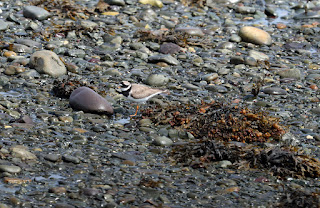Just when it looked like we might miss Common Ringed Plover this month for the first August in a few years, a beautiful example of the species appeared out of nowhere at Renews on 26 August. Even before the car rolled to a complete stop I had my eye on this one. The high contrasting dark marks around the head and the white supercilium looked right. A quick glance through binoculars solidified my initial impressions. Here is the very first picture.
First picture of the Common Ringed Plover
Even at this range the strong clear cut black head markings and long white line over the black ear patch spelled Common Ringed Plover. The thick black breast band helped too. For the next 45 minutes I got lucky photographing this bird from the car on a hot day (26 C with high humidity) with limited heat shimmer next to a road busy with Sunday drivers, occasional dump truck and walkers. Below are selection of the closer shots. Any farther away and the heat shimmer started to have serious effect.
Pretty good view of the lack of webbing between middle and outer toe.
Alarm mode as a noisy truck passed on the road.
There seems to be a lack of webbing between the middle and outer toes which is right for CRPL.
------------------------------------------------------------------------------
The three pictures below are of a fairly boldly marked Semipalmated Plover photographed the week before (19 August 2018) on the Burin Peninsula. After saturating your brain with all the above images of a Common Ringed Plover (CRPL) note how different a Semipalmated Plover (SEPL) appears. It is a combination of features that cause the affect. SEPL have a much more subdued white supercilum (line over eye) most of the time. Female SEPL can have extensive white superciliums but they are also less well marked around the head so the classic neatly stamped out, high contrast head markings of a CRPL are lacking. On SEPL the black cheek patch (auriculars) tends to dip down then comes to met the bill almost pinched off. On CRPL the lower edge of the cheek patch is straighter and the black area where it meets the bill is wider therefore creating and more even width black mask over all. The orbital ring (fleshy ring around eye) is usually black on CRPL but can be yellow during high breeding condition. On SEPL it is usually obviously yellow but can be extremely difficult to see in the field even close up. The white across forehead comes to a point and points in under the eye on CRPL but on SEPL the white is blocked off more squarely against the black in front of the eye. The breast band on a SEPL can look wide and of course varies depending on posture but usually narrows considerably more in the middle and never really matches the very wide breast band of a classic CRPL. The CRPLs that Newfoundland receives are paler on the back and have a yellower tinge to their bright orange legs compared to SEPL. Just more cosmetics that make a Common Ringed Plover a really distinct bird when you know your Semipalmated Plover. There are other fine details that you can find in the field guides or in Dave Brown's most recent blog posting http://birdingnewfoundland.blogspot.com/2018/08/common-ringed-plover-in-north-american.html#!/ .
Using webbing or lack of in the toes is treading on dangerous grounds when separating these two plovers. This is a classic SEPL toe webbing showing webbing between the middle and outer toe and no webbing between middle and inner toe.. But the same bird could seeming hide the webbing if its toes were perhaps more relaxed. I have photos showing such magic on other SEPLs somewhere in my collection.































































